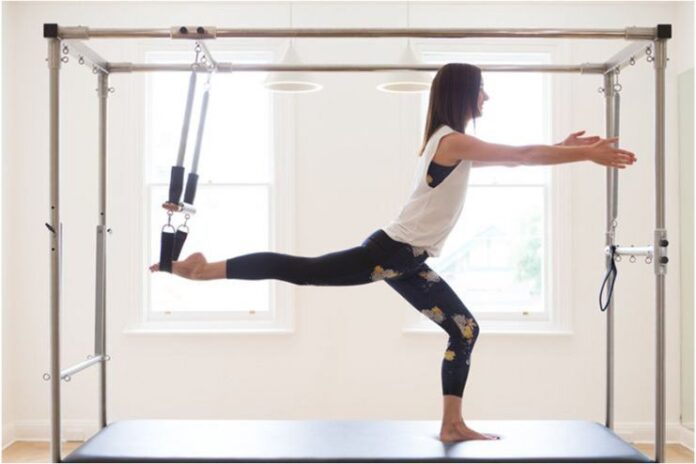Pilates has gained massive popularity in recent years. Fitness enthusiasts swear by this exercise for its immense benefits. Pilates is not a routine exercise, it‘s a thoughtful system of movement that builds, stretches, and supports the body.
Created by Joseph Pilates during the early 20th century, this approach emphasizes precise movement, core strength, and good posture to build overall health. Whether done on a mat or with special machines such as reformers, Pilates is a whole-body solution to fitness that enhances strength, flexibility, and consciousness.
In this article, we will learn more about Pilates and its benefits. We will also provide an informative guide on 10 easy Pilates exercises for beginners.
Benefits of Pilates
If you wish to include pilates in your regimen, here are a few solid reasons to do so. Read on to learn the benefits of Pilates.
- Core Strength: Pilates engages deep core muscles, such as the abdominals, back, and pelvic floor, to form a solid foundation for movement. An effective core promotes stability, lowers the risk of injury, and facilitates improved posture.
- Flexibility: In contrast to static stretching, Pilates enhances flexibility using dynamic movement that lengthens and strengthens muscles at the same time. This leads to an increased range of motion and decreased muscle stiffness over time.
- Posture: Through attention to alignment and muscle activation, Pilates assists in the correction of poor posture patterns. Stabilizing postural muscles can alleviate back pain and avoid imbalances in the future.
- Balance and Coordination: Pilates tests stability by using controlled movement that activates many muscle groups simultaneously. This promotes coordination, prevents falls, and enhances functional movement in everyday activities.
- Mind-Body Connection: Pilates focuses on conscious movement, which demands focus and control over breathing with each movement. It encourages body consciousness, allowing people to move more effectively and with control.
Read More: The Power of Pilates: Daily Routines for Strength and Flexibility
10 Essential Pilates Exercises For Beginners
Pilates is an extremely beginner-friendly exercise, and if you fall into that category, do not worry. We have listed a few essential yet easy pilates exercises for beginners:
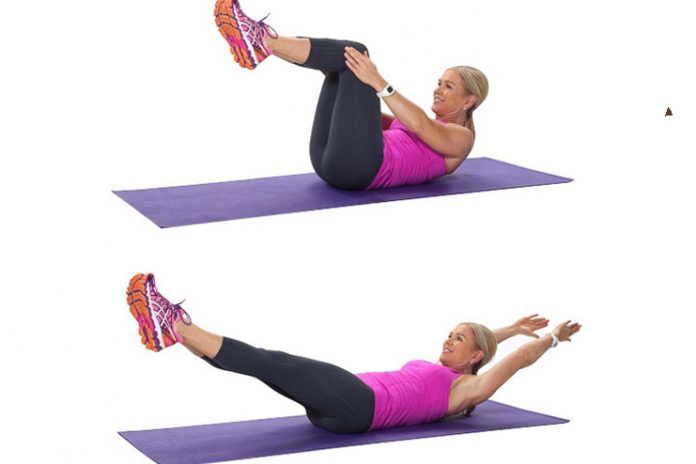
Control must be maintained continuously in the Double Leg Stretch as both arms and legs extend simultaneously. This double-leg stretch engages the core, strengthens the hip and thigh muscles, and enhances coordination between the upper and lower body.
- Lie on a yoga mat with your spine in a neutral position.
- Curl up slightly, raising your shoulders from the mat while contracting your core.
- Maintain your abdominal contraction to stabilize your lower back during the movement.
- Extend your arms overhead, keeping them close to your ears.
- Lift your legs and bend your knees towards your chest.
- Keep your knees between your hands and keep them firm as you resume the repetitions.
- Repeat 10-15 times.
22. Pilates Scissors
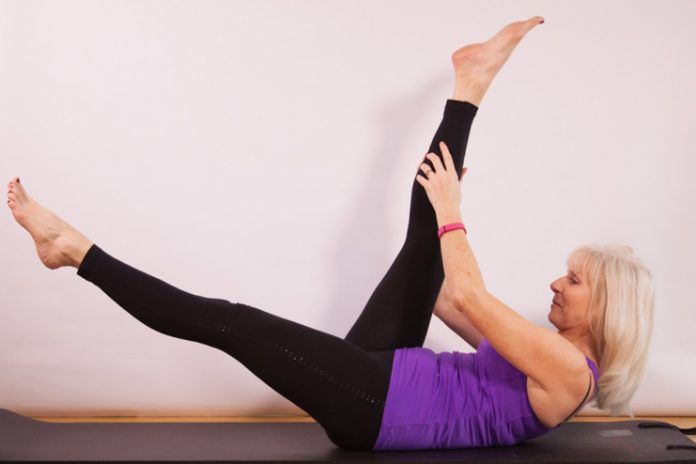
The Pilates Scissors exercise tones the core by contracting the rectus and transverse abdominis and stretching the hamstrings via controlled leg extensions.
The alternating motion enhances coordination, which demands precision and balance. The exercise also increases flexibility in the hips and legs, allowing for a wider range of motion.
- Lie down on the yoga mat with your spine neutral.
- Tuck your head and neck slightly to raise them from the ground, activating your core.
- Lift one leg up toward the ceiling while the other leg is straight and hovering 1–2 inches above the mat.
- Hold the lifted leg in place by holding onto the ankle with both hands.
- Alternate legs in controlled motion while staying balanced and stable.
- Maintain tight, stable hips throughout the action.
Do it for 15–20 reps, aiming to move slowly but smoothly.
33. Pilates Curl
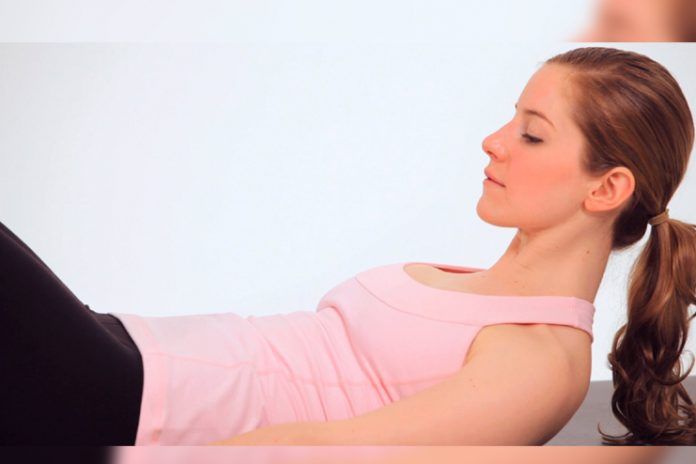
The Pilates Curl tones the core by contracting the rectus abdominis and deep abdominal muscles while also increasing spinal flexibility and control. It increases neck and upper body strength, enabling improved posture and less strain.
The controlled movement promotes coordination through the need for accurate breathwork and body awareness. Pilates Curl also creates a strong mind-body connection as it needs focus and controlled performance.
- Lie on your back with your knees bent, your feet flat on the ground, and your arms at your sides.
- Breathe in to set up, then breathe out as you tuck your chin towards your chest, activating your core.
- Lift from the breastbone, relaxing the neck to prevent strain.
- Maintain the position for a brief moment, keeping controlled breathing.
- Breathe in as you slowly return to the initial position.
- Repeat while focusing on core activation and smooth, controlled movement.
- Repeat 20 times.
Read More: Top 5 Pilates Balls for Core Strengthening and Rehabilitation
44. The Hundred
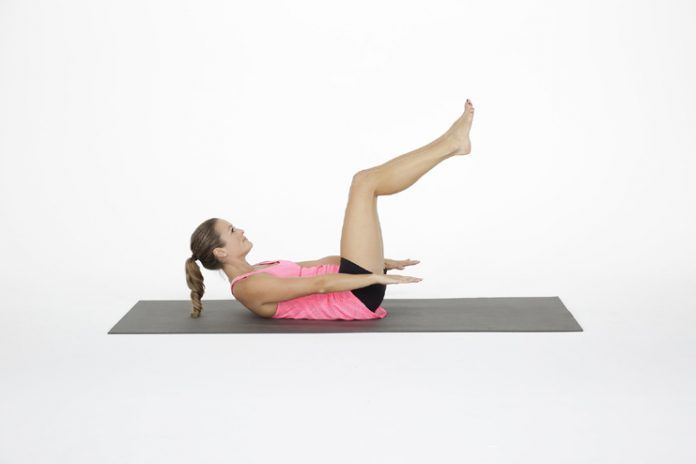
The Hundred is a powerful core exercise that strengthens the deep abdominal muscles, including the transverse and rectus abdominis, while improving endurance and stability. The continuous arm pumps challenge muscular stamina and improve circulation, while the controlled, rhythmic breathing increases lung capacity and oxygen flow.
This exercise also promotes full-body engagement by activating the arms, legs, and core simultaneously, improving coordination and balance.
- Lie face up on the mat with your legs out straight.
- Raise both legs to 45 degrees, keeping them straight and active.
- Put your arms at your sides with palms facing down.
- Raise your head, neck, and shoulders off the mat, engaging your core.
- Lift your arms 6–8 inches above the ground and start pumping them up and down in a controlled manner.
- Inhale for five counts and exhale while keeping a consistent rhythm as you repeat the movement.
- Repeat 25 times.
55. Pilates Roll Up
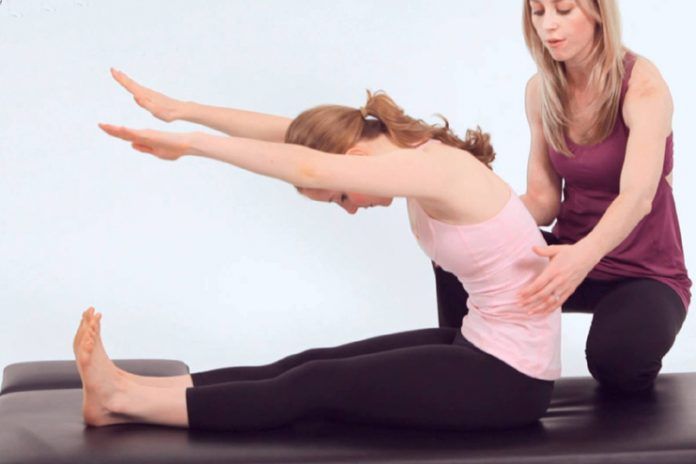
The Pilates Roll-Up is a mat exercise that strengthens the core, increases spinal flexibility, and promotes general body control. It is a flowing, controlled motion from the lying position to the sitting position using the abdominals and increasing flexibility.
- Lie face up on your yoga mat with your legs extended.
- Stretch your arms toward the ceiling, keeping them at a 90-degree angle from the floor.
- Engage your core and slowly roll up to a seated position, reaching your hands toward your feet.
- Inhale as you lift, maintaining a smooth, controlled motion.
- Exhale as you slowly roll back down, vertebra by vertebra.
- Move gently without jerking, focusing on core engagement and spinal articulation.
- Repeat 20 times.
Read More: Tuesday Toning: Core-Focused Pilates Session
66. Pilates Double Tabletop
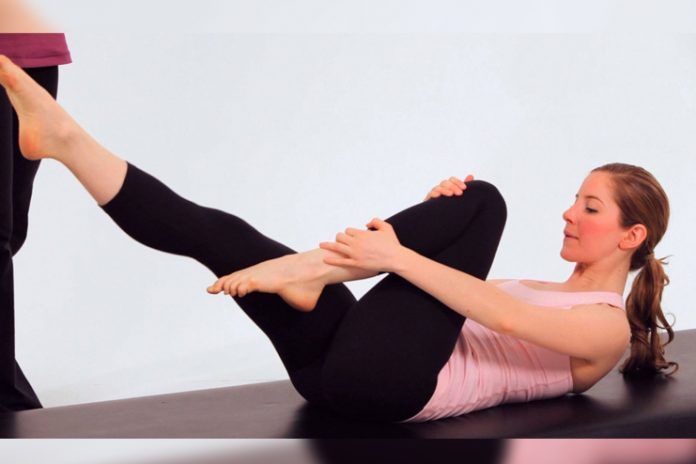
This Pilates Double Tabletop with Abdo Prep Position builds core strength, enhances coordination, and increases endurance. It targets the hip flexors and quadriceps while maintaining spinal stability. The controlled breathing enhances lung capacity and endurance, making it a dynamic full-body exercise.
- Lie face up on the mat with your spine in a neutral position.
- Draw your knees toward your chest, keeping your shins parallel to the floor.
- Lift your head, neck, and shoulders off the mat, engaging your core.
- Extend one leg straight at a 45-degree angle while drawing the other knee toward your chest.
- Hold the bent knee with the opposite hand, the left hand on the right knee, and the right hand on the left knee.
- Maintain control and fluidity as you alternate legs, focusing on stability and breath coordination.
- Alternate with the two legs 20 times.
77. Swan
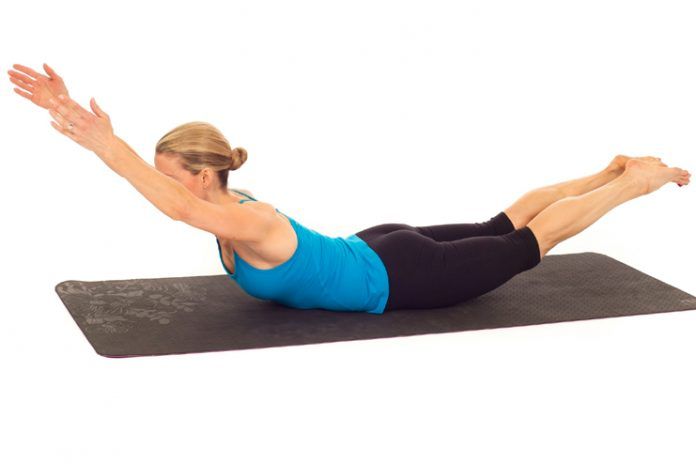
The Swan or Swan Dive in Pilates is an extension of the back that works the spine, core, and upper body. It is a classic Pilates mat exercise that promotes flexibility and can be adapted for varying levels of fitness.
- Lie on your yoga mat face down with your hands under your shoulders.
- Tilt your head up a little, keeping your neck in a neutral position.
- Raise your chest while extending your arms forward.
- At the same time, raise your legs approximately an inch off the mat, contracting your glutes and lower back.
- Bend elbows to create a “W” shape with the arms.
- Maintain the position for a few seconds before slowly returning to the mat with control.
- Repeat 15-20 times.
88. Rolling Like A Ball

The Rolling Like a Ball exercise targets the core, increases balance, and enhances spinal flexibility by maintaining a controlled, rounded position.
The rolling motion lightly massages the spine, improving circulation and releasing tension while inducing relaxation. It also reinforces the arms-to-core connection, promoting improved coordination and body awareness.
By adding this exercise to your regimen, you build stability, control, and a more flexible, healthy spine.
- Sit on the yoga mat with knees down towards the chest.
- Arms must be wrapped around the legs.
- Now with your back taking the base, roll from your hips to your shoulders on the mat.
- Hold your legs while doing this.
- Inhale, roll back, and exhale rolling down.
- Use abs to control momentum.
- Pause before your feet touch the mat.
- Repeat 20 times.
Read More: Pilates Mat vs. Reformer: Exploring the Benefits of Each for Your Fitness Goals
99. Single and Double Leg Stretch
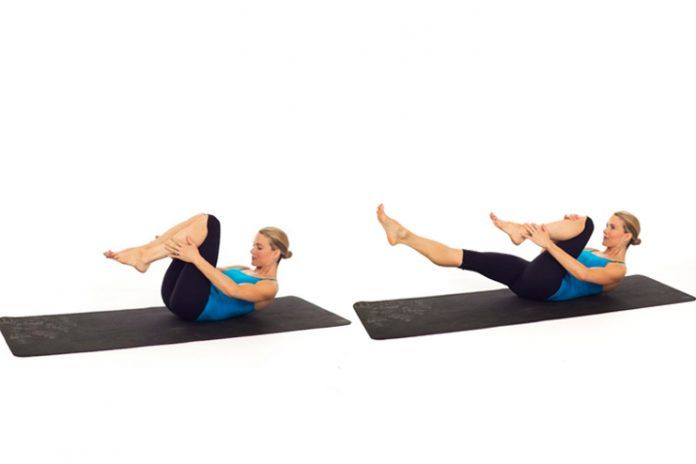
The Single Leg Stretch strengthens the core, improves coordination, and enhances spinal mobility. It also engages the hip flexors and promotes breath control for better endurance.
The Double Leg Stretch challenges core stability, increases flexibility, and boosts coordination. It strengthens the hip flexors while improving breath control and full-body awareness.
- Lie facing upwards on your yoga mat with a straight spine.
- Bring your knees towards your chest—both knees for Double Leg Stretch, each one separately for Single Leg Stretch.
- Exhale as you bring your head, neck, and shoulders off the mat, engaging your core.
- Stretch out one leg straight to 45 degrees while bringing the other knee towards your chest (for Single Leg Stretch).
- Alternate legs in controlled motion, with shoulders raised and breathing normally.
- For Double Leg Stretch, extend both legs out while raising your arms above you, then return them in while holding both knees.
- Keep your core engaged and repeat 20 times with smooth, controlled motion.
1010. Double Leg Kick
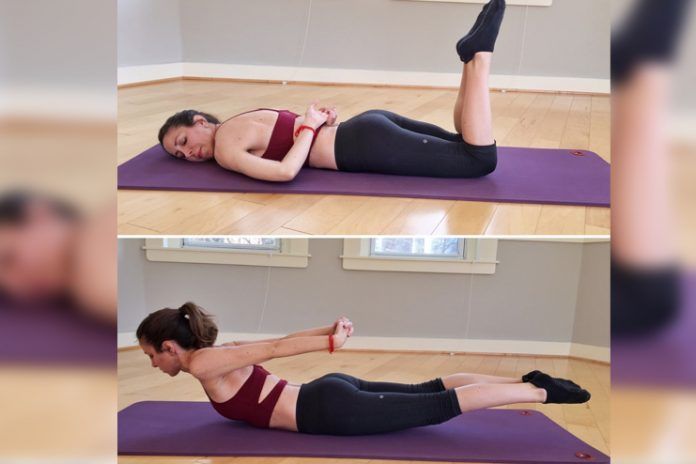
The Double Leg Kick in Pilates involves the back, glutes, and hamstrings to develop strength while improving spinal flexibility and posture. It enhances chest and shoulder flexibility, reversing the adverse effects of prolonged sitting.
The controlled movement promotes coordination, core engagement, and breathing control, making it an excellent full-body exercise.
- Lie face down on your yoga mat with your right cheek on the mat.
- Put both hands on your lower back, one on top of the other, with your elbows relaxing towards the ground.
- Bend your knees and push your heels towards your glutes in a controlled manner.
- Straighten your legs while your feet remain elevated off the ground.
- Lift your chest slightly without overextending, engaging your back muscles.
- Lower your chest again and rotate your head to the other side to do the movement again.
- Repeat 15-20 times.
11Conclusion
Pilates is a holistic practice that tones, stabilizes, and flexes, with the ability to create a profound sense of mind-body connection.
From the Hundred to build stamina, the Single and Double Leg Stretch to enhance coordination and central control, or the Scissors and Double Tabletop to refine accuracy and balance, each exercise has a specific function.
The Double Leg Kick and Swan Dive both enhance posture and spinal flexibility, but the focused breathing continues as an underlying focus throughout.
All the pilates exercises in this article help your body function efficiently and with poise. As they become habitual, they don’t just build up and shape the muscles but can also improve the full-body conditioning, enabling you to move more efficiently and assertively in the world.
Stick with it, be attentive, and indulge in the magic of Pilates!
Share ahead and keep commenting, we love to hear from you!
-
Apr 2017Written by Minu Manisha
-
Apr 2025Edited by Vaishnavi
12References
- https://www.pilatesclub.de/en/pilates-exercise-double-leg-kick/
- https://www.quietbodies.com/blog/the-pilates-single-leg-and-double-leg-stretch-replay
- https://pilatesology.com/the-pilatesology-encyclopedia/rolling-like-a-ball/
- https://pilateslive.co.uk/pilates-exercises/pilates-exercises-one-leg-stretch/
- https://complete-pilates.co.uk/pilates-roll-up/
In this Article















